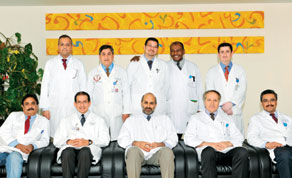Qatar has one of the highest road traffic death rates in the region at 19 deaths per 100,000 people, according to a report by the World Health Organisation.

Doctors working in the trauma section pose for a photo
The report also said trauma was a major cause of death and disability in the country while accidents, mostly at construction and other work-sites, were cited as the second most common cause of death and permanent impairment.
The Hamad Hospital trauma registry shows that in 2010, the trauma service treated and discharged an average of 2,300 patients.
According to the WHO report, the demographics for trauma patients in Qatar are unique compared to the US, Australia or Europe, with the population of trauma patients about 94% male and 6% female, rather than a balanced mix.
It attributed the high figures partly to culture and partly to the booming economy and construction happening throughout the Gulf area.
Meanwhile, the WHO report has recognised the Hamad Hospital’s innovation of formalising trauma service in country.
In the report entitled “Strengthening Care for the Injured: Success Stories and Lessons Learned from Around the World,” the WHO featured Hamad Hospital’s achievements while describing its trauma service as an international success story.
“Hamad Hospital is one of the first countries outside the US to have a complete trauma system. This means we do not only have acute care, but we have pre-hospital care, acute trauma care, critical care service, rehabilitation, injury prevention programme and a trauma registry,” Trauma Intensive Care director and Trauma consultant/Critical Care surgeon Dr Ahmad Zarour said.
The trauma service is a specific, dedicated multidisciplinary service designed to optimise outcome for the injured.
“The trauma service brings together a team of professionals with interest and expertise in trauma care, ensuring that injured patients are provided with high quality care based on international standards,” Dr Zarour said.
He said trauma service acted as an advocate for the patient, working to ensure that no findings were overlooked in the process of identifying injuries and prioritising patient management.
“Congratulations and thanks go to Qatar and HMC leadership at all levels, the trauma surgeons, critical care doctors, nurses, and support staff of the Trauma Surgery section for their dedication to improving care for the injured and towards making Qatar a leader worldwide in trauma care,” Dr Zarour said.
“The success of this service is reflected in the decreasing mortality and morbidity in trauma patients. Services are being provided in a timely fashion, in line with our goal to provide ‘the right care at the right time, to the right person’,” he explained.
Dr Zarour said that through proper co-ordination and communication by trauma services, the length of hospital stay has reduced from an average of 12 days to six for the trauma patient, adding that critical patients needing surgery now have a waiting time of less than one hour.
He said that the HMC board of directors had in November 2008 endorsed the concept of “Trauma Centre of Excellence” to be developed according to American College of Surgeons criteria.
“We are working to obtain accreditation from the American College of Surgeons, which would mean international recognition for Hamad Hospital as one of the first level one trauma centres outside the US,” he said.
The WHO report aims to share information about programmes across the globe which proved beneficial in improving trauma care, focusing on practical, affordable and sustainable efforts.
Contributors to the Qatar case study were Dr Zarour, Dr Abdulwahab al-Musleh, who initially directed the trauma surgery section, and trauma service former director Dr Kimball Maull.
The trauma service is currently headed by Dr Hassan al-Thani.



